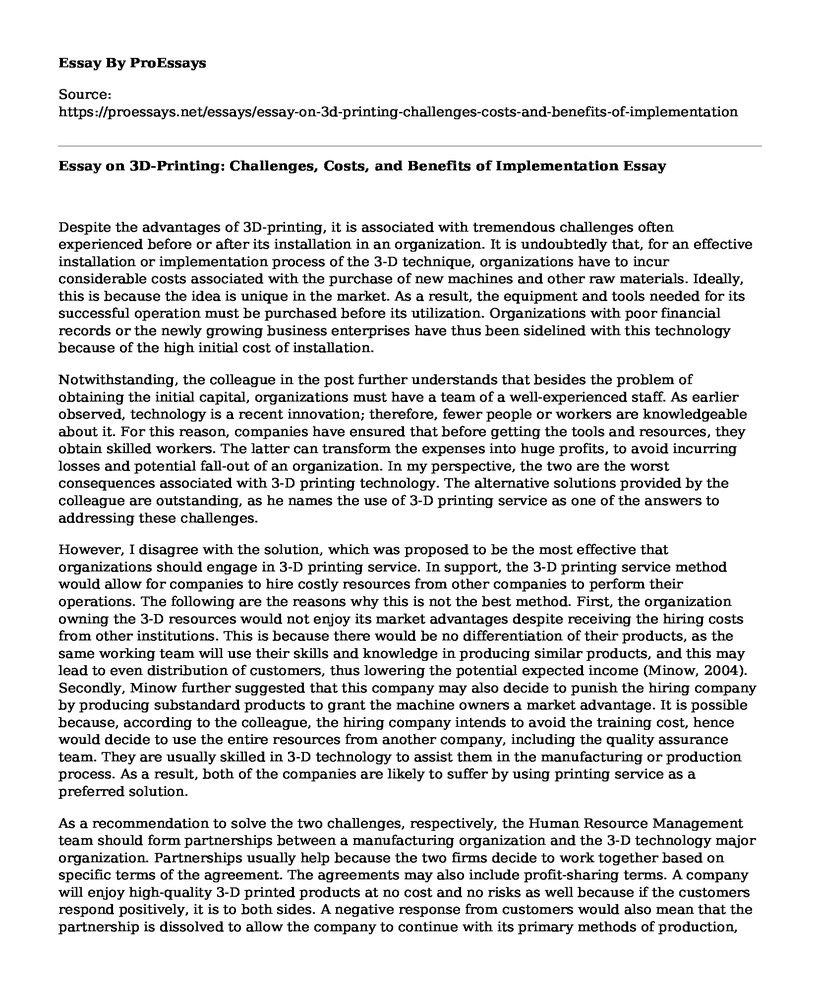Despite the advantages of 3D-printing, it is associated with tremendous challenges often experienced before or after its installation in an organization. It is undoubtedly that, for an effective installation or implementation process of the 3-D technique, organizations have to incur considerable costs associated with the purchase of new machines and other raw materials. Ideally, this is because the idea is unique in the market. As a result, the equipment and tools needed for its successful operation must be purchased before its utilization. Organizations with poor financial records or the newly growing business enterprises have thus been sidelined with this technology because of the high initial cost of installation.
Notwithstanding, the colleague in the post further understands that besides the problem of obtaining the initial capital, organizations must have a team of a well-experienced staff. As earlier observed, technology is a recent innovation; therefore, fewer people or workers are knowledgeable about it. For this reason, companies have ensured that before getting the tools and resources, they obtain skilled workers. The latter can transform the expenses into huge profits, to avoid incurring losses and potential fall-out of an organization. In my perspective, the two are the worst consequences associated with 3-D printing technology. The alternative solutions provided by the colleague are outstanding, as he names the use of 3-D printing service as one of the answers to addressing these challenges.
However, I disagree with the solution, which was proposed to be the most effective that organizations should engage in 3-D printing service. In support, the 3-D printing service method would allow for companies to hire costly resources from other companies to perform their operations. The following are the reasons why this is not the best method. First, the organization owning the 3-D resources would not enjoy its market advantages despite receiving the hiring costs from other institutions. This is because there would be no differentiation of their products, as the same working team will use their skills and knowledge in producing similar products, and this may lead to even distribution of customers, thus lowering the potential expected income (Minow, 2004). Secondly, Minow further suggested that this company may also decide to punish the hiring company by producing substandard products to grant the machine owners a market advantage. It is possible because, according to the colleague, the hiring company intends to avoid the training cost, hence would decide to use the entire resources from another company, including the quality assurance team. They are usually skilled in 3-D technology to assist them in the manufacturing or production process. As a result, both of the companies are likely to suffer by using printing service as a preferred solution.
As a recommendation to solve the two challenges, respectively, the Human Resource Management team should form partnerships between a manufacturing organization and the 3-D technology major organization. Partnerships usually help because the two firms decide to work together based on specific terms of the agreement. The agreements may also include profit-sharing terms. A company will enjoy high-quality 3-D printed products at no cost and no risks as well because if the customers respond positively, it is to both sides. A negative response from customers would also mean that the partnership is dissolved to allow the company to continue with its primary methods of production, and no losses will be incurred. Different from the colleague's idea, this method would ultimately benefit the organization at zero cost (Sirajuddin et al., 2017).
References
Minow, M. (2004). Outsourcing power: How privatizing military efforts challenges accountability, professionalism, democracy. BCL, Rev., 46, 989.
Sirajuddin, S. N., Siregar, A. R., Nurlaelah, S., Lestari, V. S., & Tenrisanna, V. (2017). The limitations and benefits of partnership sharing system of Corporated Cattle Market (CCM). American-Eurasian Journal of Sustainable Agriculture, 11(1), 11-15.
Cite this page
Essay on 3D-Printing: Challenges, Costs, and Benefits of Implementation. (2023, Jun 06). Retrieved from https://proessays.net/essays/essay-on-3d-printing-challenges-costs-and-benefits-of-implementation
If you are the original author of this essay and no longer wish to have it published on the ProEssays website, please click below to request its removal:
- Marketing Essay Example: Market of Solar Panels in United Kingdom
- Report on the Virtual Workplace Incorporation of Augmented Reality and Virtual Reality
- Philosophical Considerations on the Future of Artificial Intelligence Essay
- Essay Example on Online Security: A Must-Have Tool to Guide Clients?
- AI: Man-Made Reasoning - Exploring the Possibilities
- Essay Example on Will Humans Win the Race Against Machines? AI and the Digital Revolution
- Essay Example on Securing Digital Data: Cybersecurity Strategies and Tactics







